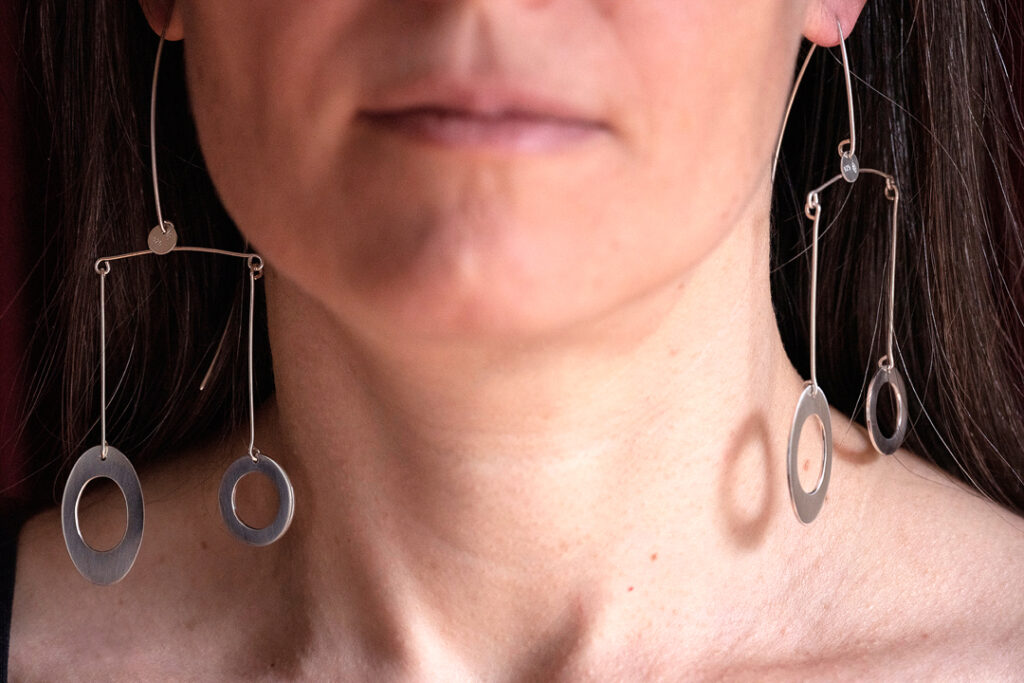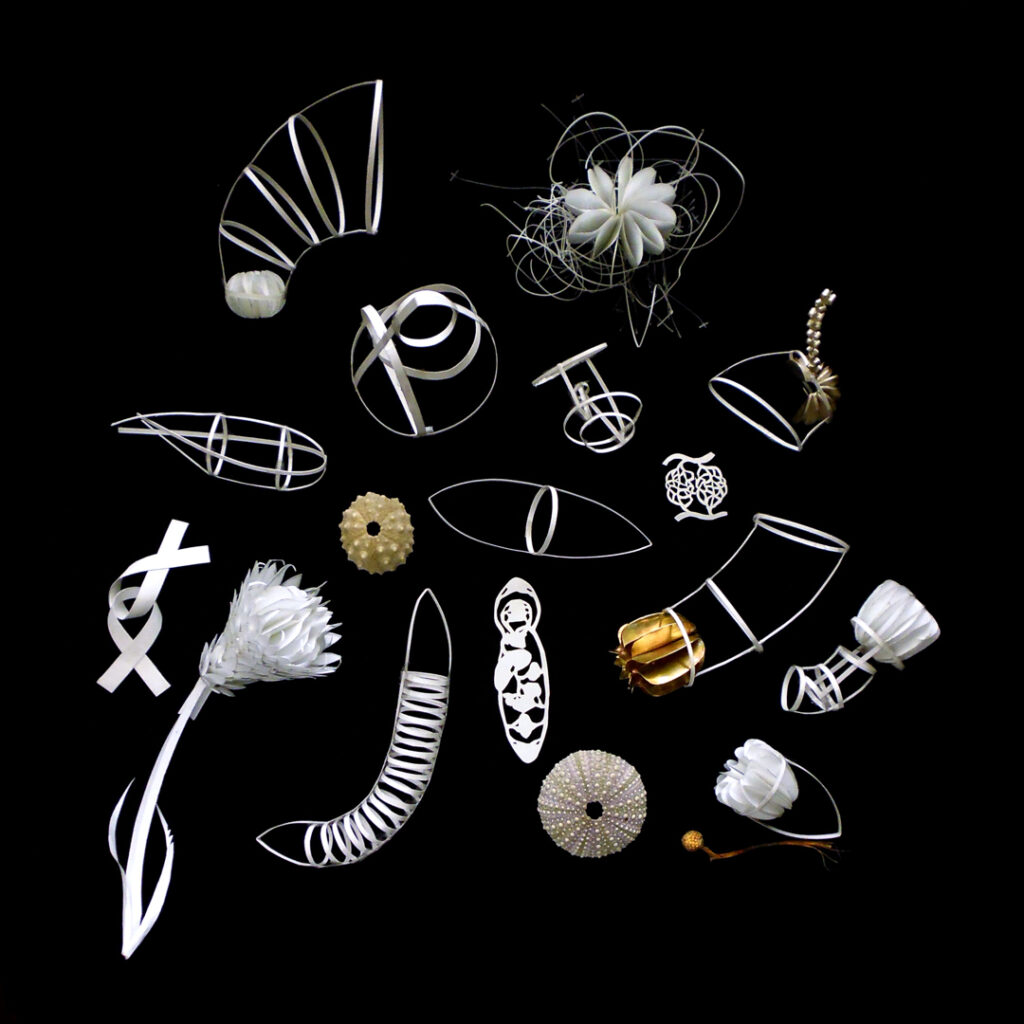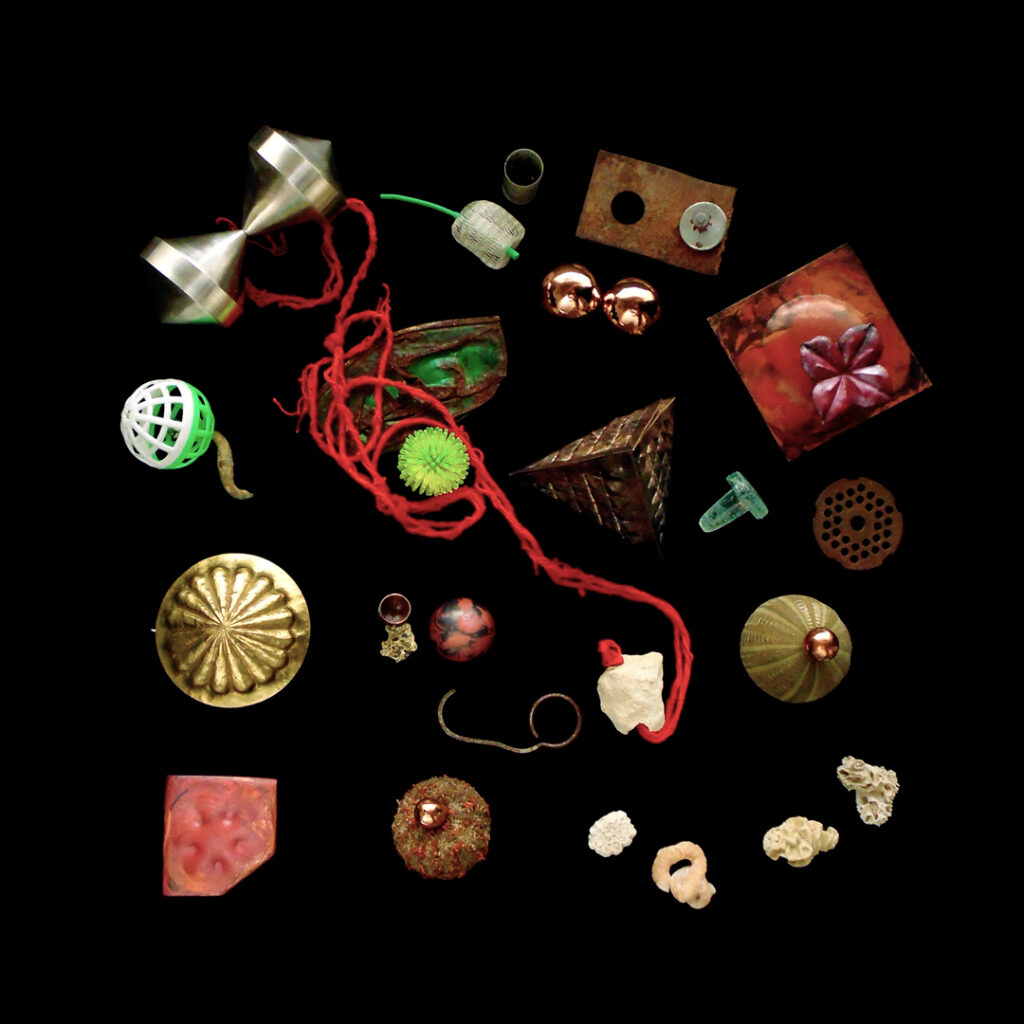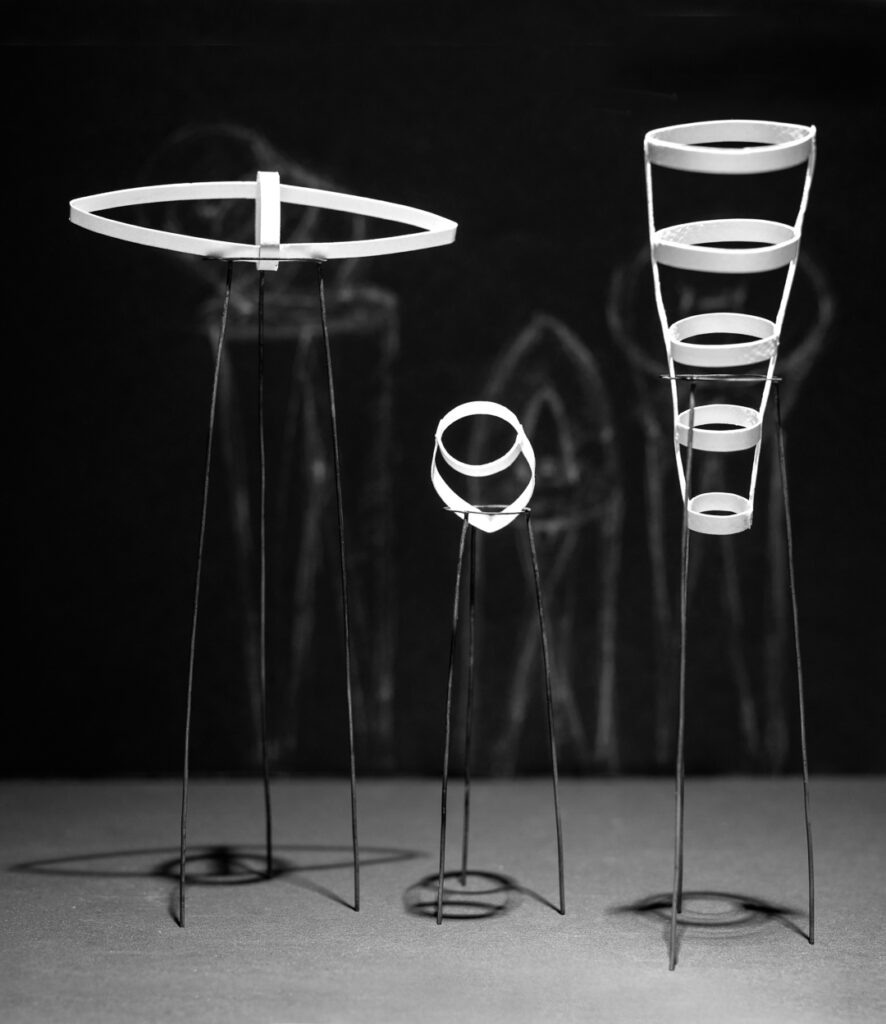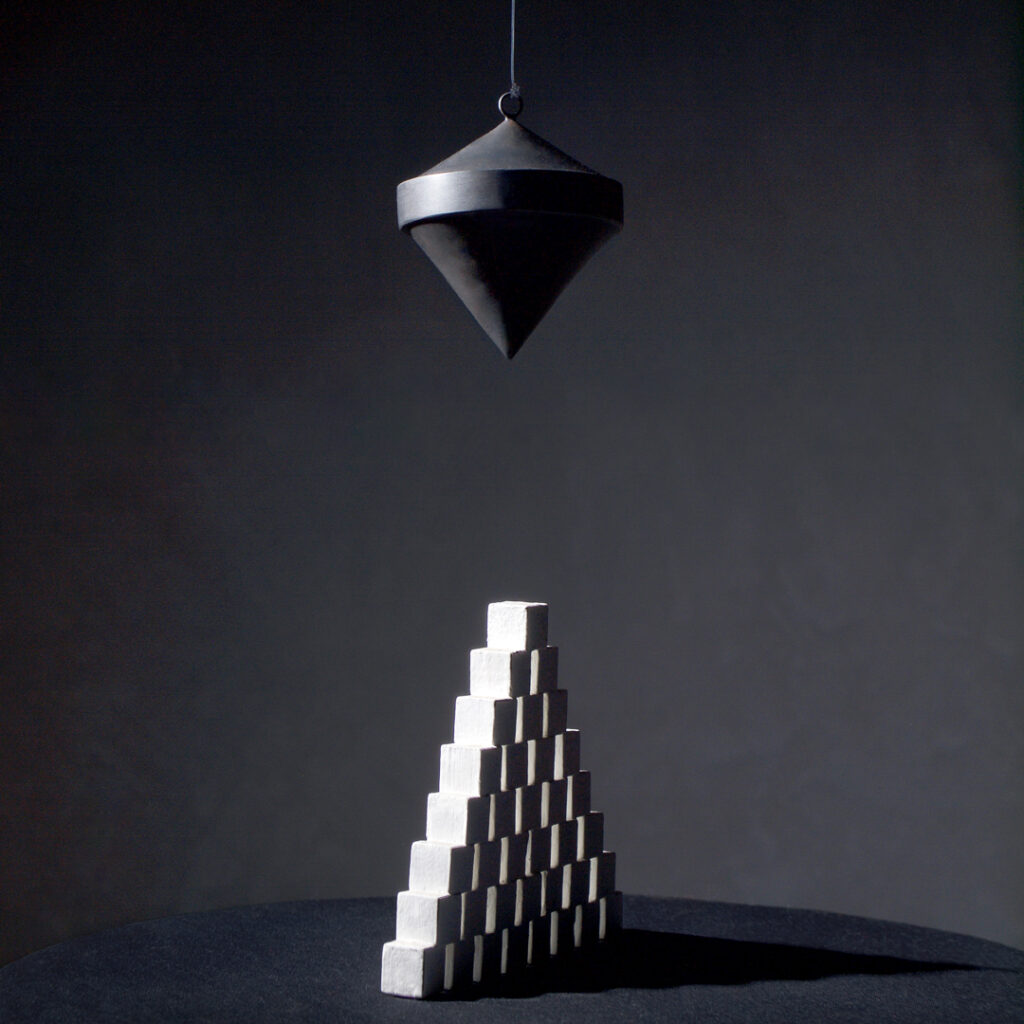Mem Capp writes about her identical twin sister, Melinda Capp, whose finely hammered jewellery work evokes reflection and doubles.
If you hold a mirror up in front of you, another you appears. A double. Like the splitting of an egg in utero to make two. A kind of pattern making seen on a larger scale throughout the natural world where the replication of cells forms the basis of life.
As early as 200 BCE, the Indian poet and mathematician Pingala explored pattern-making through a cultural lens by experimenting with the sounds created in Sanskrit poetry of light and heavy syllables. He is credited with developing the binary number system to calculate variations in Vedic metres with the aim of forming pleasing sounds and compositions; known as “Matrameru”, an algorithm based on the power of 2 to calculate number sequences. It was a thirteenth-century Italian mathematician however, Fibonacci, who introduced this notion of numerical patterning sequences into Western thought and was able to demonstrate its prevalence throughout not only the natural world but in the geometry of architectural design and many forms of artmaking.
Jewellery artist Melinda Capp plays with this notion of the double and explores the possibilities of pattern-making through replication in her art.
Up a flight of stairs, I follow a labyrinth of corridors to find Melinda’s studio. After a disrupted year of moving both home and studio, she has finally settled into her new space. Part of a larger studio complex set in an old warehouse in Melbourne’s inner north. I stop at the door and listen to the tap-tapping coming from within and then silence. On entering I am greeted with a range of varying sized pieces of equipment required to create her art. This small space has a sense of warmth and welcome with carefully arranged objects of interest drawing the eye around the room. At her work bench, Melinda is busy with some pieces for a new series of works.
- Melinda Capp, Sketches, Paper sculptures, made & found objects, mixed media, size variable, photo Daniel Armstrong
- Melinda Capp, On going explorations, objects made & found-, 2017-19, mixed media, size variable, photo Daniel Armstrong
- Melinda Capp, Understructure 3 sculpture,2021, paper & oxidised copper, size variable, photo Daniel Armstrong
- Melinda Capp, Point of balance. sculpture, 2018, oxidised copper, & painted wood, size variable, photo Daniel Armstron
Later, looking through her website, I am drawn to shapes rising out of the black of the background. These intricate skeletal-like geometric forms made from paper, metal or from the natural world demand the viewers’ attention with their reoccurring patterns and fine details. The inspiration was ancient cellular forms such as radiolaria; microscopic sea life that produce wonderful complex patterning to form their outer mineral skeletons.
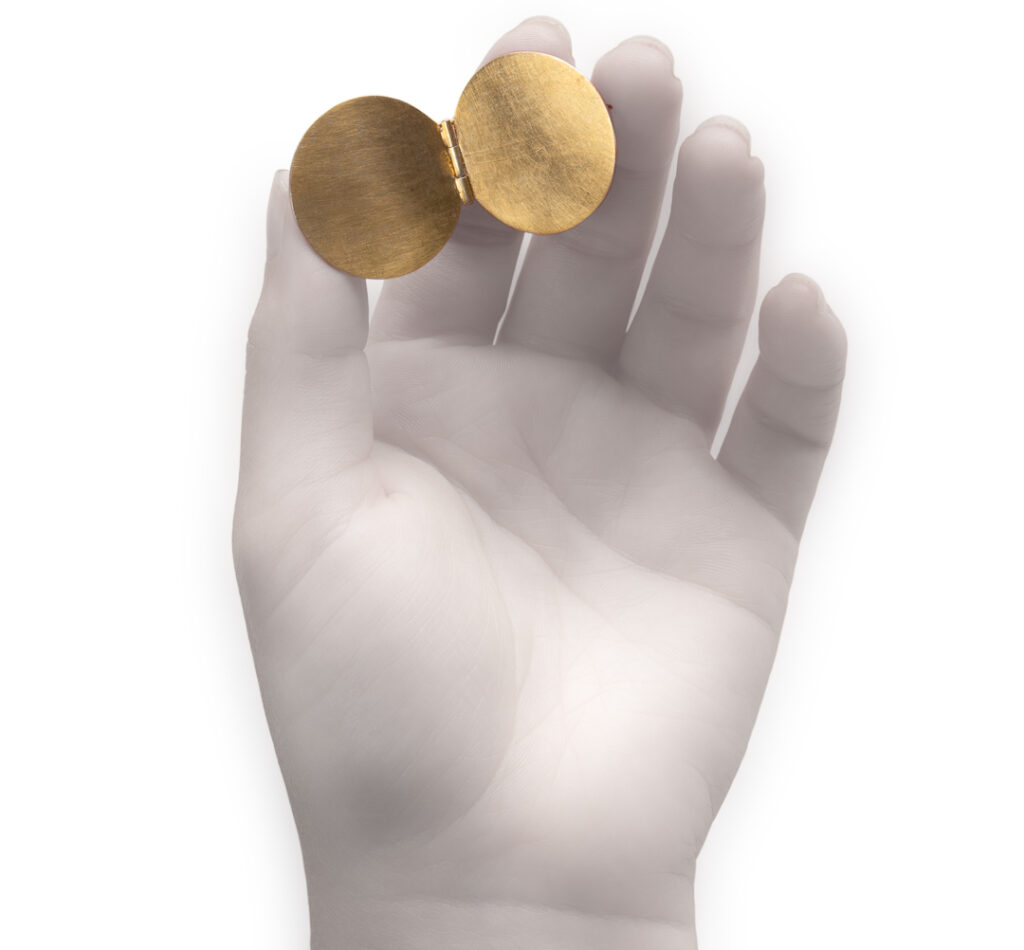
Melinda Capp, Hinged brooch,2020, Sterling Silver & gold foil brooch, size variable, photo Daniel Armstrong
As my identical twin sister, ‘a double’, I am fascinated by Melinda’s creative story, separate from my own. I am curious about her choice of a medium that utilises materials that require a sense of measure, patience and application so different from my way of working and the art I produce: The paradox of a mirror twin, similar yet opposite, a reflection perhaps of life’s larger picture.

Melinda Capp, Nature nurture, pendant 2016, Sterling silver brass, size variable, photo Daniel Armstrong
Informed by both the natural and built environment Melinda’s earlier jewellery work can be seen as an extension of her initial training. A playful sculptural work called “I Can’t Hear You” is a trumpet necklace made from brass. A pendant-like piece “Nature/nurture”, inspired by the shape of a test tube uses repeated circles from silver and brass to give both structural integrity and visual interest, provoking thoughts of biological duplication.
With an honours degree in fine art majoring in sculpture from Monash University, she later undertook an advanced diploma in jewellery and object design from Melbourne Polytechnic. Melinda’s work is represented in both public and private collections and has been the recipient of and short-listed for various awards, her work features in numerous publications.
In her practice she explores what would appear to be two quite different aesthetics; the intricate and the minimal, the ancient and the contemporary: Her work is informed by such artists as the Australian metalsmith Julie Blyfield and American sculptor Alexander Calder.
Using techniques such as chasing and repoussé Melinda’s focus is on texture and volume. Both ancient techniques, chasing and repoussé involve creating outlines and volume on a sheet of metal using hammer and punches which can be combined or used separately. Achieving the desired thickness through using a rolling mill she is then able to cut out the shapes from the metal sheeting by using a jeweller’s saw.
In her 2018-2021 “Sea life series”, repousse brooches and pendants in sterling silver, take on the quality of a sea urchin shell when the spines have dropped off to reveal small protruding circles radiating with mathematical precision from a circular form. There is a sense of the ancient, of timelessness, about these works, as though they’ve been excavated from the depths of the sea floor.
The circle is an important shape in Melinda’s work and is suggestive of the splitting of the egg through mitosis. Through this process, a cell replicates its chromosomes and segregates them to produce two identical nuclei to form a life. Melinda’s “Duplication series”, 2023 of earrings and necklaces in sterling silver reflects this reproductive cycle. In “Repetition 2”, a pair of earrings draw on her fascination with mirror pairs by allowing the wearer to move the small circular parts to face and reflect each other. Another work, a minimalist necklace piece called “Layering”, plays on her love of patterning by overlaying different-sized circles. The incorporation of red thread in some of these works builds on the notion of connection through family and bloodlines.
She is currently finalizing some large Paste Up works as part of Radiant Pavilion. The work will be displayed on the outer wall of Bar Oussou in Florence Street, Brunswick. Using AI technology and romanticised landscape backdrops, Melinda’s jewellery art takes on another dimension in these images where the sense of the precious in a beautifully crafted object touches on the precious in our environment as well as the conflict between the mining of precious metals and the ongoing social and environmental impacts of these practises.
As I leave her studio, walking along the maze of corridors to the outside world, the thrum of my feet brings to mind the prosody of a Sanskrit sruti. “The Perfect Prayer”, so called because of its message about the perfection of creation in its sound and fullness, purity and the precision of each syllable; aiming to still the mind and open the heart, it captures something of both nature’s wonder and the wonders of the artist’s creation.
Visit melindacapp.net and follow @min_capp
Mem Capp is an artist & writer living in Naarm, Melbourne

